Color Grading and Lighting for Insecure Set
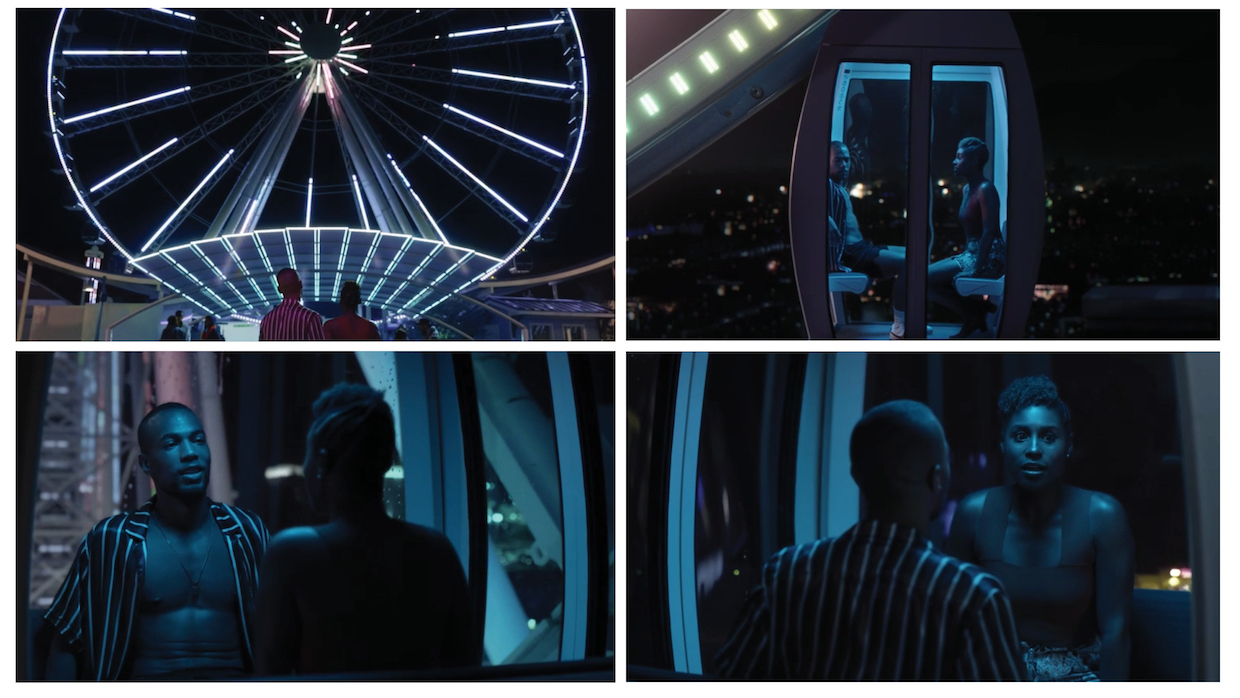 Insecure
Insecure
A row of symmetrically stacked airport luggage carts; the tumbling red-and-blue cylinders of a 7-Eleven Slurpee dispenser; the still life of neatly arranged condiments and coffee creamers on a diner countertop. While the romantically and professionally struggling twentysomethings that populate HBO's Insecure make their share of pilgrimages to taco trucks, clubs, and even Coachella, it's those tableaus of Los Angeles at its most quotidian that make the sprawling city feel as if it's being viewed through a different lens.
With the show's third season recently wrapped up, cinematographer Ava Berkofsky spoke to Filmmaker about how she "makes L.A. feel like L.A."
Filmmaker: As with season two, you shot five episodes and then handed off three episodes to another cinematographer, this time Paula Huidobro. How did you describe the visual grammar of the show to her when she came onboard?
Berkofsky: Paula stepped in and helped elevate the show while also maintaining the consistency of the world. We have some specific visual rules, especially for lensing. Things like, "Okay, if you're five feet away and you need to do a medium close-up, rather than stepping in three feet and using a 35mm, step back one more foot and use a 50mm instead." We developed these rules last season and that was our starting point. [Executive producer and director] Melina Matsoukas and I made a look book illustrating how we'd been doing things, which served as a sort of guide for the new directors and new collaborators. It's important to everyone that the look stay consistent and Paula was able to find ways to play with and expand the language but keep it in the same world.
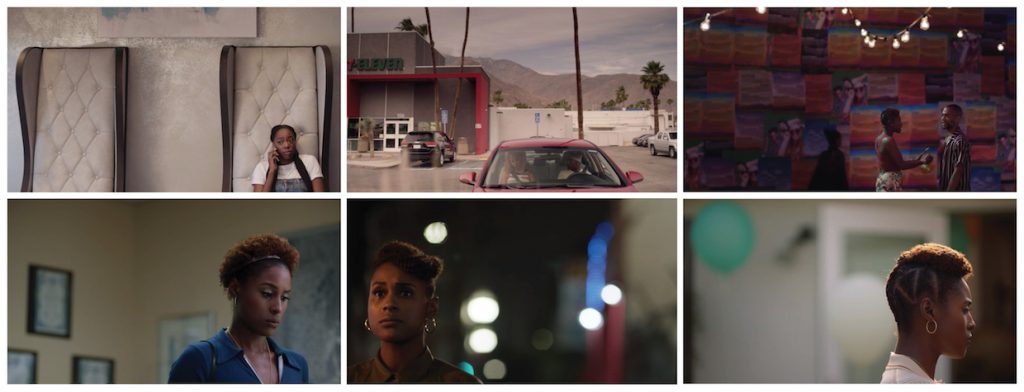
Filmmaker: Two of my favorite Insecure trademarks are short-siding characters and giving them lots of headroom to trap them in unbalanced frames. How do you decide when to use those compositions?
Berkofsky: We identify those moments as we prep the episode, moments where we want to show an imbalance or distance between the characters. Then when we're shooting the scene, we just build them into the blocking/framing. We're used to seeing frames that are balanced in a certain way and we try to play with that and use what we call an "Insecure frame," which can be shorthand for a lot of headroom. (laughs)
Filmmaker: Walk me through the camera and lenses you used for season three.
Berkofsky: We shot on the Alexa Mini with Cooke S5/i primes. I love those lenses. They're very beautiful. We had two full sets of primes because we're always on them. We also carried an Angenieux 24-290mm for when we were on cranes, but we rarely used it.
Filmmaker: Insecure's cinematography has such a distinctive eye for L.A. I know you grew up in California, but I don't know which part. Did you spend any time in L.A. as a kid?
Berkofsky: I spent a chunk of my childhood there. I lived in L.A. for seven years and then I lived up in the mountains in California for four years. I eventually moved to New York, but I've been back in L.A. about four years now. After being away for so long, the quality of light here strikes me all the time now, and I'm sure it strikes a lot of people. Insecure is so specific to L.A. so I'm always trying to capture things that make L.A. feel like L.A., which is so much about the warm light and the colors of the city.
Filmmaker: If you're shooting an exterior, is there a trick to capturing that light at its most flattering?
Berkofsky: I feel like the thing that works best for our medium when shooting digitally is subtractive light. So I do a lot of subtracting. I very rarely add light for a daylight exterior. Almost never. I'll soften and bounce the [sunlight], but I try to embrace it and let it into the image rather than trying to make it be perfect.
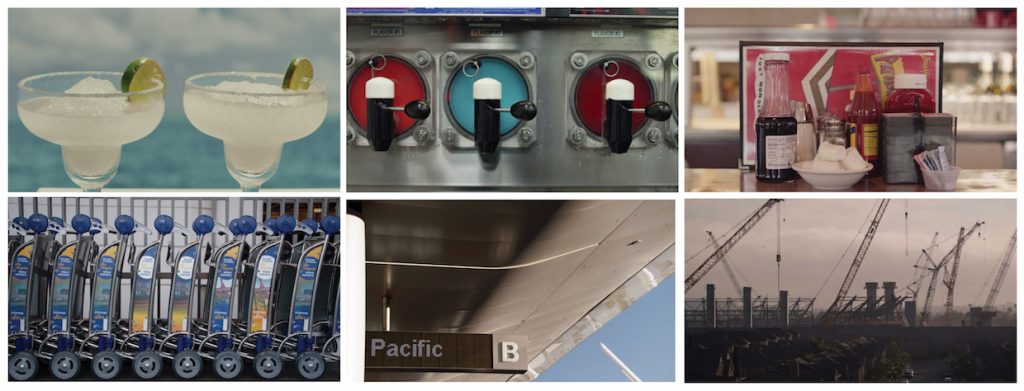
Filmmaker: The show's establishing and transition shots play a big role in showing a side of L.A. I haven't seen much in movies and shows. There's a long tradition of bland establishing shots in television—where we see the same image over and over again of the coffee shop on Friends or Jerry's apartment on Seinfeld—but you're three seasons into Insecure and you're still not repeating yourself. How do you come up with creative ways to utilize shots that are often treated as disposable connective tissue?
Berkofsky: It's hard! We're really specific about them and we try to pick things that tell you something about where you are that's real and not generic. I think it's important that we don't fall into what I call "Seinfeld shots." Usually myself or [showrunner] Prentice Penny will pre-shoot the frames with a DSLR or Artemis on the scout, then we aren't deciding on them on the shoot day.
Filmmaker: Are the bird's-eye-view shots of the city done with drones?
Berkofsky: Yeah, we have an amazing drone guy. I believe it's Ian Wood at Silly Goose Media. Those are also very specific and they're color graded specifically because they're shot on a different format. So getting them in the same world color-wise as our Alexa Mini footage takes a minute.
With shooting the drone footage, there's just not room in the schedule [to shoot them as part of the main unit]. Last year Melina worked with Ian to get him in the ballpark of what we were looking for, and he's done a great job since [going out and shooting footage on his own].
Filmmaker: Since you mentioned color grading, what is your on-set approach to your color workflow? Are you somebody who likes to use LUTs?
Berkofsky: For this show I used LUTs very heavily. I was able to do some extensive testing (prior to season two) and then go into Company 3 and work with colorist Dave Hussey. We made a series of LUTs. I think we originally made about eight of them for different environments and on set I'll expose to those LUTs. We mostly used the same ones for seasons two and three.
Filmmaker: A large section of episode five takes place at Coachella. Did you get permission to shoot there or did you have to recreate that experience?
Berkofsky: It's all fake. (laughs) The Coachella people wouldn't let us shoot there because of logistical reasons, so we recreated everything you see in that episode. It kind of has a Season Finale epic-ness to it in terms of scope, but we created all of that from scratch in a bunch of conglomerated fields in Ventura. All the departments worked together to create just enough to see the specificity of it and allude to the size of it. I thought Kay Lee, our production designer, really worked some magic.
We did get to go to Coachella to do research, which was really helpful. Myself, the gaffer, the director, the assistant director, the production designer, and the set decorator, all went and took notes. Our gaffer Danny Durr was able to source some of the same lighting units we saw at the shows and that was helpful in recreating it. None of us had ever been to Coachella, actually, so it was helpful to be there and soak in the colors and the vibe.
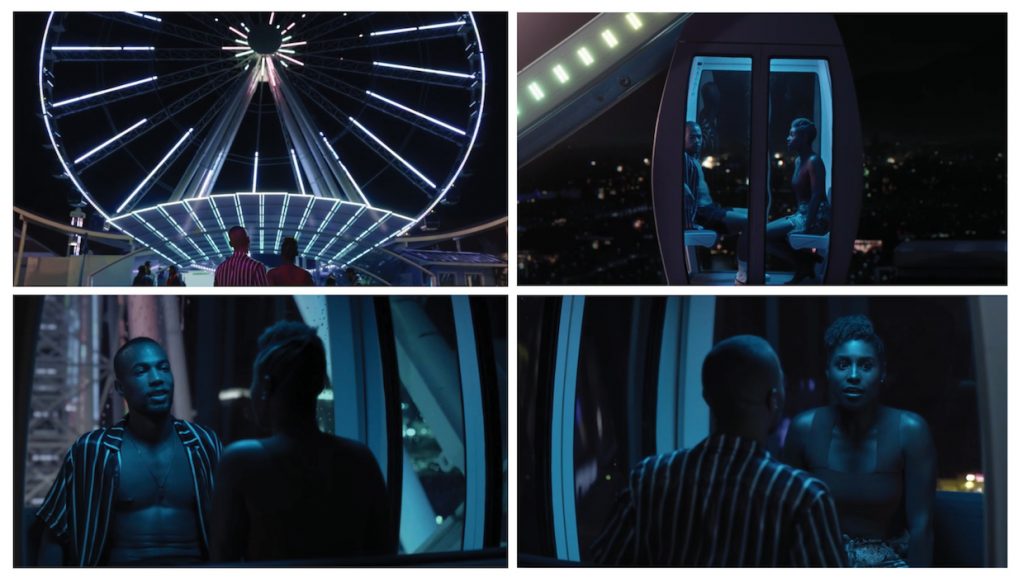
Filmmaker: There's a love scene between Issa (Insecure's lead character, played by series co-created Issa Rae) and her barber love interest Nathan on the Coachella Ferris wheel. Did you have to rent one and have it hauled out to that lot in Ventura?
Berkofsky: There's only like two of those in the U.S, so that scene is the only greenscreen part of that episode. There's one or two other VFX shots where you see the Ferris wheel in the distance, but we shot all of the gondola stuff —that's what the Ferris wheel car things are called, gondolas—on stage. Construction built a few of them and we elevated them against a greenscreen. The actual Ferris wheel at Coachella had horrible lighting. It was bright, unflattering light. So we took some creative license with the lighting and the color palette, but the gondola itself is pretty much an exact replica of the real Ferris wheel at Coachella.
Filmmaker: How did you light the interior of the gondola? Did you get that cyan-ish color with LEDs that let you dial in the color temperature?
Berkofsky: We used LEDs, but we gelled them. I find that sometimes, especially when the lights are in close proximity to the actors, the color of RGB LEDs doesn't quite blend right with skin tone. For that scene we used either Sourcemaker LED Blankets or small LiteMat pieces that were gelled and then softened—I can't remember which. It was tough because there's nowhere to hide light in there. Then we lit the greenscreen quite bright to get a proper key off of it through the layers of glass.
Filmmaker: In season two there was a Scandal-esque fake TV show that the characters watched. For season three, it's a rebooted '90s sitcom. That seems like it would be fun to shoot.
Berkofsky: Actually, my A-Camera operator Anka Malatynska, who's also a DP in her own right, stepped up and shot that because it had to be done at the same time as regular production. Kim Fields, who played Tootie on The Facts of Life, directed it. She's directed a lot of muti-cam sitcoms and knows the formula well. It was like its own completely distinct unit with a real multi-cam sitcom director and we got real multi-cam sitcom operators in there. They really tried to treat it like making a '90s sitcom.
Filmmaker: Did they shoot just those few moments we see on Insecure or did they shoot entire scenes?
Berkofsky: They just made what you saw. There's not a whole world that got made. (laughs) That would be awesome, though. I wish they'd done that last year [with the Scandal spoof Due North].
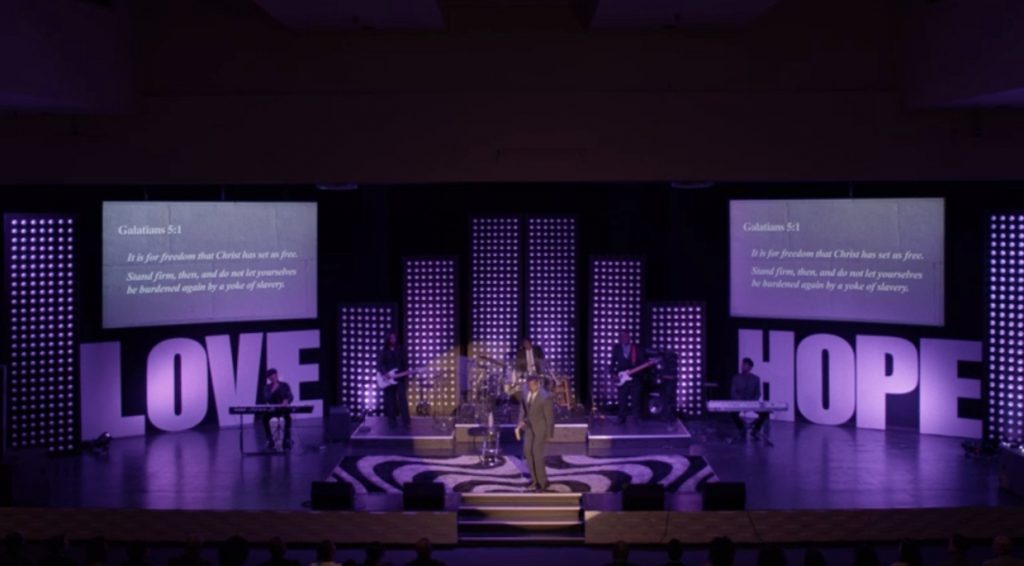
Filmmaker: Another space that seemed challenging to light is the megachurch that Lawrence goes to in Episode Seven.
Berkofsky: Megachurches are really hard. The recessed lighting in spaces that big is dim and not great. The church where we shot had a stage system with these pre-made looks. We were able to tweak that system and add some of our SkyPanels to make the lavender look we ended up going with. One of the issues with consumer grade LED lights is that they flicker differently depending on the color and intensity. So a blue will flicker a little differently than a red, and then you have to compensate with your shutter angle, and that affects the other lighting you're using as well. We also used a spotlight that we made quite cool [to light the preacher played by Mykelti Williamso]) and some balloon lights in the audience just to give us a controllable base.
Filmmaker: During season two, you did an interview for Mic that extensively detailed your approach to lighting the show's wide variety of skin tones. With a new game-changing piece of LED technology coming out seemingly every year, did you find any new tools that were useful for darker skin tones for season three?
Berkofsky: My base approach was the same. I'm always subtracting and bouncing light and using a polarizer to shape. Actually, this year I did start using Asteras, which are these fluorescent tubes that are pixel-mapped and RGB. They're surprisingly not that expensive—I mean, they're expensive, but not as expensive as one would expect from a new technology. I used those all the time this season, whereas they didn't exist for me last season. They hadn't mainstreamed yet, but Danny Durr, my gaffer, was like, "You have to check these out" They have their drawbacks, but I was so impressed with the way they treated skin tones.
Filmmaker: How's the output on them? Do they have enough punch to be your key in a wider shot?
Berkofsky: That is their problem. Their punch isn't as much as one would like as a key light. What we would do is gang them up in Kino housings and stack them together. Also, because they're battery operated, if you program them as though they are going to run for a shorter time, like six or eight hours, instead of programming that they're going to have to run for 12 hours, they give you more punch. But that takes planning because there constantly has to be charging and swapping happening and you have to keep rotating them.
Filmmaker: Season three doesn't have as many dimly lit night interiors like clubs and restaurants, but when you do have those scenes is it difficult to use the polarizer? How much stop do you lose with that filter?
Berkofsky: You lose about 1 3/4 of a stop and yes, it can be annoying. (laughs) We're all used to shooting at a very forgiving 800 ASA. But the Alexa is very light sensitive and our base [ISO] was 1250, so [shooting with the pola] was really like shooting at 500, which is not bad.
Matt Mulcahey works as a DIT in the Midwest. He also writes about film on his blog Deep Fried Movies .
Color Grading and Lighting for Insecure Set
Source: https://filmmakermagazine.com/106136-insecure-dp-ava-berkofsky-on-avoiding-seinfeld-shots-faking-coachella-and-lighting-mega-churches/